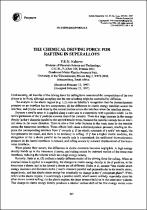JavaScript is disabled for your browser. Some features of this site may not work without it.
- ResearchSpace
- →
- Research Publications/Outputs
- →
- Journal Articles
- →
- View Item
| dc.contributor.author |
Nabarro, FRN

|
|
| dc.date.accessioned | 2007-06-08T06:28:19Z | |
| dc.date.available | 2007-06-08T06:28:19Z | |
| dc.date.issued | 1997-08-15 | |
| dc.identifier.citation | Nabarro, FRN. 1997. Chemical driving force for rafting in superalloys. Scripta materialia, vol. 37(4), pp 497-501 | en |
| dc.identifier.issn | 1359-6462 | |
| dc.identifier.uri | http://hdl.handle.net/10204/444 | |
| dc.description | Copyright: 1997 Pergamon-Elsevier Science Ltd | en |
| dc.description.abstract | The author provides a brief overview of the chemical driving forces for rafting in superalloys. Until recently, all theories of the driving force for rafting have considered the compositions of the two phases to be fixed, although accepting that the rate of rafting might be controlled by diffusion. The analysis in the elastic regime (e.g. 1,2) rests on Eshelby’s recognition that the thermodynamic pressure on an interface has two components: (i) the difference in elastic energy densities across the interface, and (ii) the work done by the normal traction across the interface when the interface moves. | en |
| dc.language.iso | en | en |
| dc.publisher | Pergamon-Elsevier Science Ltd | en |
| dc.subject | Chemical driving forces | en |
| dc.subject | Thermodynamic pressures | en |
| dc.title | Chemical driving force for rafting in superalloys | en |
| dc.type | Article | en |
| dc.identifier.apacitation | Nabarro, F. (1997). Chemical driving force for rafting in superalloys. http://hdl.handle.net/10204/444 | en_ZA |
| dc.identifier.chicagocitation | Nabarro, FRN "Chemical driving force for rafting in superalloys." (1997) http://hdl.handle.net/10204/444 | en_ZA |
| dc.identifier.vancouvercitation | Nabarro F. Chemical driving force for rafting in superalloys. 1997; http://hdl.handle.net/10204/444. | en_ZA |
| dc.identifier.ris | TY - Article AU - Nabarro, FRN AB - The author provides a brief overview of the chemical driving forces for rafting in superalloys. Until recently, all theories of the driving force for rafting have considered the compositions of the two phases to be fixed, although accepting that the rate of rafting might be controlled by diffusion. The analysis in the elastic regime (e.g. 1,2) rests on Eshelby’s recognition that the thermodynamic pressure on an interface has two components: (i) the difference in elastic energy densities across the interface, and (ii) the work done by the normal traction across the interface when the interface moves. DA - 1997-08-15 DB - ResearchSpace DP - CSIR KW - Chemical driving forces KW - Thermodynamic pressures LK - https://researchspace.csir.co.za PY - 1997 SM - 1359-6462 T1 - Chemical driving force for rafting in superalloys TI - Chemical driving force for rafting in superalloys UR - http://hdl.handle.net/10204/444 ER - | en_ZA |






